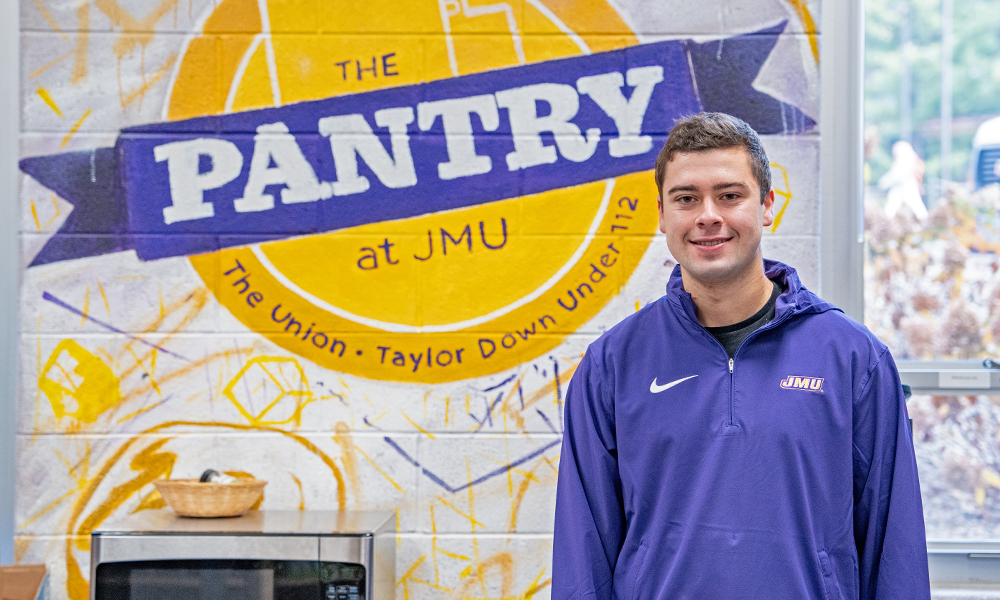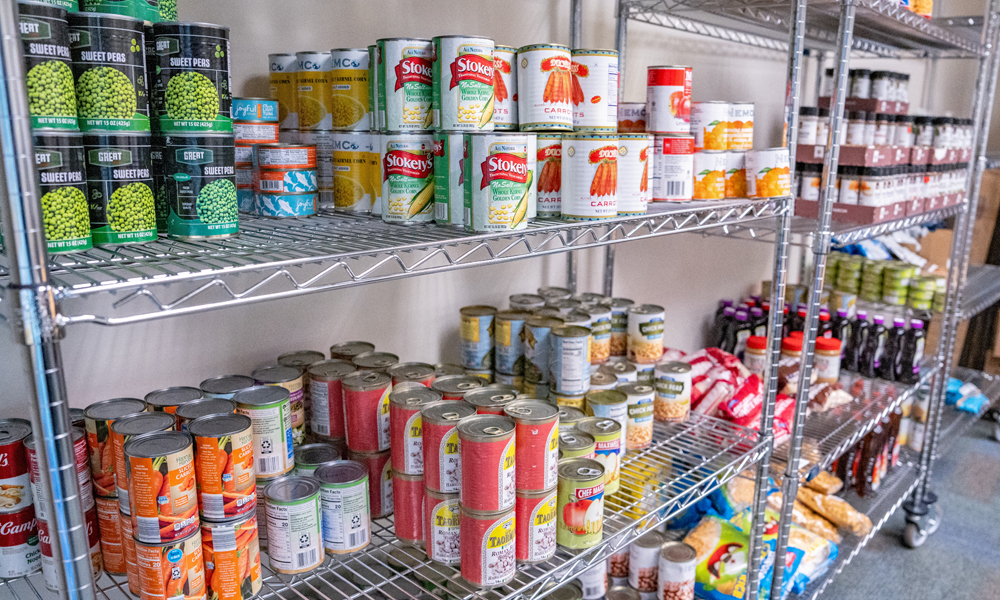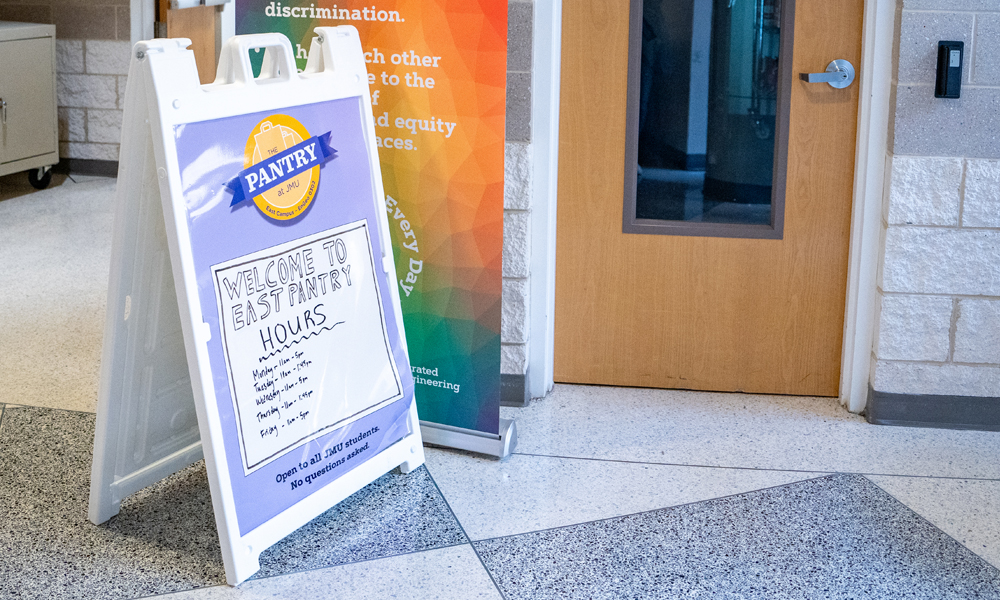'A quiet crisis'
JMU’s free food pantry feeds a rising need
JMU Headlines
SUMMARY: The Pantry at JMU, which provides supplemental resources for food-insecure students, has seen five times the foot traffic since it first opened as a pop-up location in early 2020. Now with two thriving locations led by Dukes and AmeriCorps VISTA Evan Dribbon (’22), The Pantry has plans to open a third location later this semester to allow for greater access to food, clothes and other essential items.
Since it opened as a pop-up in early 2020, The Pantry at JMU has seen an almost fivefold increase in clients. It’s been so popular that it moved to a permanent location in Taylor Down Under that summer and, in the spring of 2023, opened a second location on East Campus.
But The Pantry’s success also highlights some unpopular realities, specifically that more than a third of American college students — including nearly 40% of JMU students — experience food insecurity.
“Food insecurity, it’s really just a symptom,” said Les Sinclair, communications and public relations manager of the Blue Ridge Area Food Bank, which contributes food to The Pantry each Monday. “It means that they don’t have enough money.”
The Pantry, located in TDU, Room 112, and the Engineering/Geosciences building, Room 0302, is open to all students, no questions asked, and offers nonperishable items. Students gather items they need and have them weighed so the Pantry’s student employees can track how many pounds of food are leaving.
“And then you’re on your way,” said Evan Dribbon (’22), an AmeriCorps Volunteer in Service to America, who is four months into a yearlong term working full time with The Pantry. No names are taken. Students can also order through The Pantry at JMU app and pick up their orders later.

The Pantry is supported by the school’s Basic Needs Advisory Board, which includes faculty, staff, students and community partners who aim to better serve students facing financial hardship. The board provides resources at the Student Support Hub website. The Career Closet, sponsored by the University Career Center, is also available to students in need of free business attire for job interviews and other more formal occasions.
Before The Pantry opened, the Student Support Hub conducted a student survey in 2019 to gauge the need for a campus food pantry. It found that 38.9% of the 1,283 students who responded were affected by food insecurity. In 2023, when it repeated the survey, the figure was 37.8% of 1,225 respondents.
The Pantry has seen foot traffic increase by nearly 500% in the last three years. In the Spring 2020 semester, 115 students on average stopped in for food and other items each month. In 2021, that number rose to 165 and, a year later, 555. During the past month, the staff counted close to 600 students coming to the two Pantry locations.
|
“The options just continue to grow as we understand the needs of our students.” — Evan Dribbon |
Sinclair has seen similar increases in the number of people the Blue Ridge Area Food Bank has served through The Pantry. In fiscal year 2022, the figure was 3,426 people; in 2023, it jumped to 4,097.
Food insecurity is a nationwide issue, and it’s only getting worse, he said. “During the pandemic, there were scores of cars lined up waiting to get food. We’re seeing as many or more now than during the height of the pandemic.”
Sinclair points to inflation as a big reason why it’s so difficult for people to access healthy, affordable food. “One in 12 people in our area are food insecure, and that statistic has been very stable for a while,” he said.
The food bank “is just a supplement, that’s the goal,” he said. “That’s what food banking is supposed to be. In reality, a lot of folks really depend on it.”
|
“Hunger doesn’t know anybody’s stereotype; it just exists.” — Les Sinclair |
Additional local resources include community food pantries and the Canterbury Episcopal Campus Ministry, which runs its Shelf’d project at 622 S. Main St., Harrisonburg.
“We don’t staff it,” said the Rev. Laura Minnich Lockey, chaplain and adviser. “We just have food and school supplies available.” There are no set hours; people can enter the building anytime through an unlocked door on the side porch.
The idea for Shelf’d formed in 2019 after a conversation with Stephanie Whitehouse (’20), whom Minnich Lockey recalled petitioning the church ministry to start a food pantry. After choosing a closet, they began stocking it with cans of soup, beans and vegetables; boxes of pasta; and various school supplies including notebooks, paper and index cards.
Food insecurity is a huge issue for students, Minnich Lockey said, and “we want to fix the problem.” Though Shelf’d doesn’t keep track of who comes and goes, or what food leaves the pantry, she said the project’s impact is evident when they need to restock or on the rare occasion when someone shares their story of how the pantry helped them through a difficult time.
“It makes it all feel worth it,” Minnich Lockey said. “It only takes one good story to say, ‘Yeah, we’re doing the right thing.’”

The Pantry at JMU has been doing so well that Dribbon hopes to add a third location in Memorial Hall soon. The challenge has really been making people aware of it, he said. “Knowing and needing it, those go hand in hand.”
To help get the word out to students in need, The Pantry posted a video to Instagram in February, and Dribbon added information on the Resources page of JMU’s Instagram account in September. He also wants to educate JMU staff about The Pantry’s resources, so they, in turn, can spread awareness to more students.
Dribbon, who double-majored in Justice Studies and Spanish, has always been interested in the Peace Corps and plans to pursue similar jobs after his position with AmeriCorps is complete.
|
“It only takes one good story to say, ‘Yeah we’re doing the right thing.’” — Rev. Laura Minnich Lockey |
Through his role, he’s increased the capacity of The Pantry and organized a coalition of campus pantries in Virginia. He’s also part of the Harrisonburg/Rockingham Food Coalition for local college campuses to share resources, and he’s contacted schools across the Southeast to organize the first Schools of the Sun Belt Conference Food Fight during the month of February. The competition will be a collaborative effort among pantries in the SBC to combat food insecurity and assist those in need in the campus community. Students, faculty, staff, alumni, family members and friends of the university are encouraged to participate.
“Every dollar donated is worth two points,” Dribbon said. “Hygiene products and specified food items will be worth four points. The pantry with the most points earned at the end of the competition wins.”
In addition to food-bank donations, The Pantry receives free produce from the campus dining halls and leftover bread from the local Panera each week, as well as items from various other sources. Dribbon recently headed an effort to secure deliveries of nondairy milk from the Danone plant in Mt. Crawford on Mondays. Nondairy milk, fresh produce and hygiene products are some of the most requested items, in addition to kitchen staples like flour, sugar and olive oil.

Dribbon and student Pantry workers are trained to help people fill out paperwork to receive benefits through the federal Supplemental Nutrition Assistance Program and inform them on what to expect in the weeks after submitting their claims. “The options just continue to grow as we understand the needs of our students,” Dribbon said. Though The Pantry receives regular donations, he said they can always use more and a greater variety.
The Blue Ridge Area Food Bank also accepts donations of food, though it prefers monetary donations at its website, because it can provide more meals to guests with money than with individually donated products. While a can of vegetables might cost someone a dollar, Sinclair said, “With one dollar, we can help provide four meals.”
Food insecurity is “a quiet crisis,” he added. “There are so many outward signs of other things … but hunger is so inward.”
Because it’s often a hidden issue, food insecurity carries a stigma. People who haven’t experienced poverty or food insecurity might not fully understand the challenges people face, such as child care costs and jobs that don’t pay a living wage. College students are burdened with stigmas, too.
“There are a lot of not-so-rich kids who have gone off to college and single parents trying to benefit themselves,” Sinclair said. “Hunger doesn’t know anybody’s stereotype; it just exists.”
